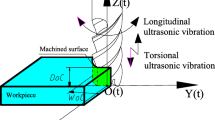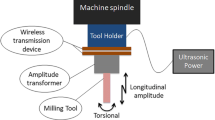Abstract
The distribution of residual stress in titanium alloy cylinder component is uneven, and there is stress concentration field in cylinder, which leads to serious processing deformation, bad tensile strength and poor fatigue resistance for component. The residual stress gradient testing was measured by critical refracted longitudinal wave (LCR wave) before and after ultrasonic regulation, and the residual stress in cylinder blank was reduced and homogenized by the method of high-energy acoustic beam regulation. The wall thickness of cylinder had effect on the distribution of residual stress and the stress control of the blank had positive influence on the subsequent processing effect. The results showed that the reduction rate of residual stress values in semi-finishing machining cylinders after regulation were more than 65% compared with that before regulation, and the homogenization rate of residual stress distributions after regulation were enhanced by more than 60% compared with that before regulation. The deformations of roundness were less than or equal 0.1 mm after ultrasonic regulation, which makes the cylinders satisfy the requirement of machining accuracy and have capability on stable shape preservation, explaining that the machining deformation can be effectively controlled by using the method of high-energy ultrasonic wave regulation. X-rays non-destructive method was used to macroscopically analyze the quality defects of cylinders, representing that the occurrence of structural quality defects in cylinders was inhibited effectively by using ultrasonic regulation technology.














Similar content being viewed by others
Data Availability
The results/data/figures in this manuscript have not been published elsewhere. The datasets generated during and/or analyzed during the current study are available from the corresponding author on reasonable request.
References
Zhao, J., Lei, J., Wang, G., et al.: Detection analysis of oil and gas transportation pipeline butt joint circumferential weld defects. Weld Pipe Tube 36(11), 43–47 (2013)
Gao, Y.: Theory and Application Residual Stresses. Shanghai Scientific & Technical Publishers, Shanghai (2019)
Jiang, X.: Investigation on the Mechanism of the Residual Stress and Control Method of Machining Accuracy for the Complex Thin-Walled Parts. Donghua University, Shanghai (2014)
Oleg, V.A.: High-Intensity Ultrasonics Theory and Industrial Applications. Gordon and Breach Science Publishers, England (1998)
Song, W.: Study on Technology of Ultrasonic Nondestructive Testing and Regulation of Residual Stress. Bei**g Institute of Technology, Bei**g (2016)
Feng, Z.: Welding Distortion and Prevention of Residual Stress. Woodhead Published Limited, England (2005)
Soyama, H., Macodiyo, D.O., Mall, S.: Compressive residual stress into titanium alloy using cavitation shotless peening method. Tribol. Lett. 17, 501–504 (2004)
Moussaoui, K., Mousseigne, M., Senatore, J., et al.: The effect of roughness and residual stresses on fatigue life time of an alloy of titanium. Int. J. Αdv Manuf. Technol. 4, 557–563 (2015)
Yu, Q.: Welding of Titanium and Its Alloys. China Machine Press, Bei**g (2020)
Tian, H., Xu, C., Lianpu, L., Wang, et al.: Nondestructive testing and control of the residual stress of rail in service. In: 18th International Wheelset Congress (IWC 2016), Chengdu, China, pp 1–5 (2016)
Xu, C., Li, P.: Stress-free manufacturing technology. J. Mech. Eng. 56(8), 113–132 (2020)
Javadi, Y., Pirzaman, H.S., Raeisi, M.H., et al.: Ultrasonic inspection of a welded stainless steel pipe to evaluate residual stresses through thickness. Mater. Des. 49, 591–601 (2013)
Song, W., Xu, C., Pan, Q., et al.: Nondestructive testing and characterization of residual stress field using an ultrasonic method. Chin. J. Mech. Eng. 29(2), 365–371 (2016)
Prabhu, N.S., Joseyphus, J., Sankaranarayanan, T.S.N., et al.: Residual stress analysis in Surface mechanical attrition treated (SMAT) Iron and Steel Component materials by magnetic Barkhausen Emission technique. IEEE Trans. Magn. 48(12), 4713–4717 (2012)
Bray, E.D.: Ultrasonic stress measurement and material characterization in pressure vessels. Pi** Welds J Press Vessel Technol. 124(3), 343–348 (2002)
Ma, Q., Huang, X., Huang, J.: Welding residual stress elimination method of typical joints of railway freight car frame bogies. Electr. Weld. Mach. 48(12), 80–84 (2018)
Gou, L., Ma, Y., Du, Y., et al.: Residual stress profile and fatigue life of 7050 aluminum plate with groove under laser shot peening. Acta Aeronaut Astronaut Sin 40(12), 1–11 (2019)
Zhu, W.H., Wang, Z.Y., Ren, J.X., Zhou, J.H.: Study on milling residual stress and deformation of TC4 titanium alloy thin plate parts. Modul Mach. Tool. Autom. Manuf. Technol. 12, 70–72 (2020). https://doi.org/10.1177/09544062231189699
Khosrozadeh, B., Shabgard, M.: Effects of hybrid electrical discharge machining processes on surface integrity and residual stresses of Ti–6Al–4V titanium alloy. Int. J. Adv. Manuf. Technol. 93, 1999–2011 (2017)
Li, J., Jia, Y.K., Shen, N.Y., et al.: Effect of grinding conditions of a TC4 titanium alloy on its residual. Surf. Stresses Strength Mater. 47, 2–11 (2015)
Yang, Y., Zhao, S., Gong, J., et al.: Effect of heat treatment on the microstructure and residual stresses in (Ti, Al)N films. J. Mater. Sci. Technol. 27(5), 385–392 (2011)
Zhang, Y., Jun, H.E., Zhai, D.P., et al.: Study on temperature field of electron beam welding of TC4 titanium alloy pressure vessel. Trans. China Weld. Inst. 38(5), 18–22 (2017)
China National Standards Committee: Non-destructive Testing—Test Method for Measuring Residual Stress Using Ultrasonic Critical Refracted Longitudinal wave. China National Standards Committee, Bei**g (2015)
Kumar, B., Jaya, B.N.: Thermal stability and residual stresses in additively manufactured single and multi-material systems. Metall. Mater. Trans. A Phys. Metall. Mater. Sci. 54, 1808–1824 (2022)
Granato, A.V., Luche, K.: Theory of mechanical dam** due to dislocations. J. Appl. Phys. 27(6), 583–593 (2004)
Guo, X.L., Li, H.W., Wang, H.L., et al.: Influence of different residual stress regulation methods on the deformation of aluminum alloy box cover. Mod. Mach. 5, 24–28 (2021)
Acknowledgements
This research was supported by Ministry of Science and Technology of China.
Funding
This work was supported by the National Key Research and Development Program of China (No. 2021YFF0600500).
Author information
Authors and Affiliations
Contributions
CJ: Writing-original draft, data analysis, checking & supervision. CX: Writing-review, project administration. PL, WS, WZ, WL, PY and WZ: Investigation.
Corresponding author
Ethics declarations
Competing interests
The authors declare no competing interests.
Ethical Approval
The authors have read and understood the publishing policy, and submit this manuscript in accordance with this policy.
Consent for Publication
The authors confirm that they understand Journal of Nondestructive Evaluation is a transformative journal. When research is accepted for publication, there is a choice to publish using either immediate gold open access or the traditional publishing route.
Additional information
Publisher’s Note
Springer Nature remains neutral with regard to jurisdictional claims in published maps and institutional affiliations.
Rights and permissions
Springer Nature or its licensor (e.g. a society or other partner) holds exclusive rights to this article under a publishing agreement with the author(s) or other rightsholder(s); author self-archiving of the accepted manuscript version of this article is solely governed by the terms of such publishing agreement and applicable law.
About this article
Cite this article
**, C., Xu, C., Li, P. et al. Study on Residual Stress and Ultrasonic Deformation Control of Titanium Alloy Cylinder Components. J Nondestruct Eval 42, 88 (2023). https://doi.org/10.1007/s10921-023-00995-1
Received:
Accepted:
Published:
DOI: https://doi.org/10.1007/s10921-023-00995-1




